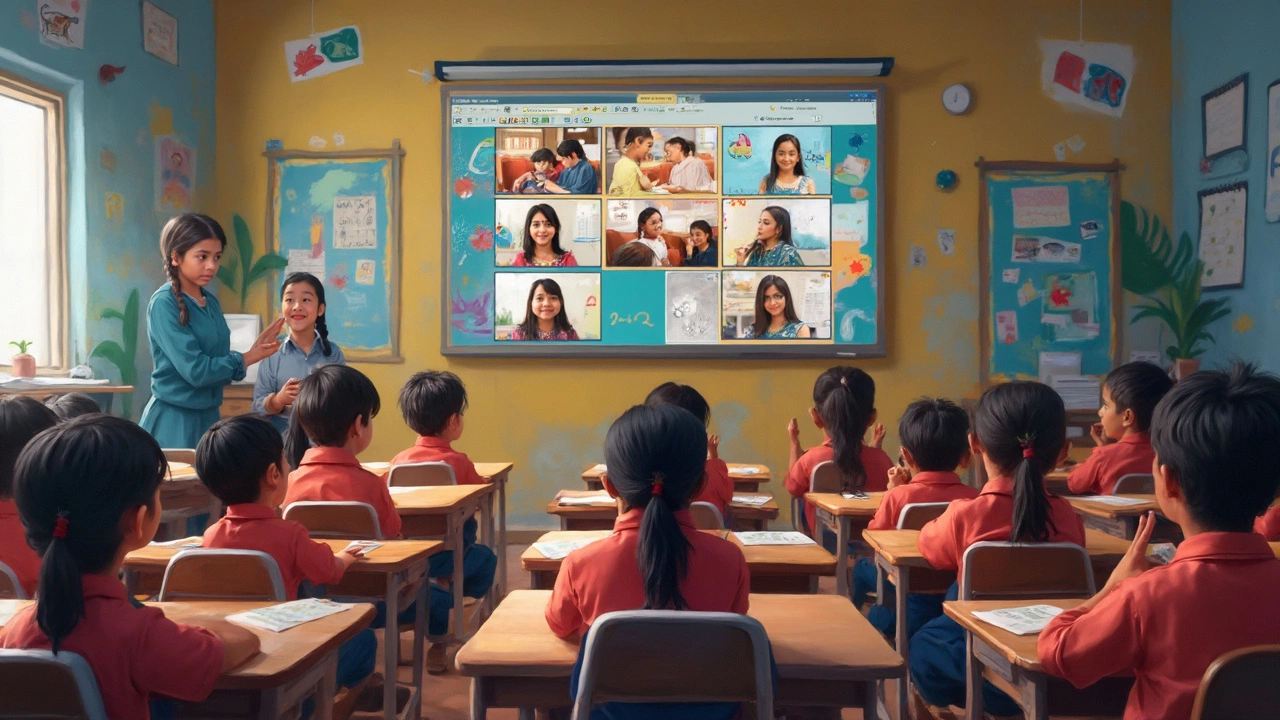
It's easy to think of virtual learning and eLearning as the same thing, especially since both involve digital platforms. But, they're actually more like siblings than twins. Virtual learning typically goes hand in hand with real-time interaction, like hopping on a Zoom call with your classmates and teacher. It's designed to mimic the brick-and-mortar classroom, just from the comfort of your couch.
On the other hand, eLearning is more like a DIY project. It's flexible, letting you decide when you want to tackle your lessons and assignments. Usually, eLearning courses are prerecorded, which means you can rewind, pause, or fast-forward as you please. This way, you're not tied to a bell schedule, but rather to your own pace.
Both have their perks and downsides, depending on what you're looking for. Whether you thrive on interaction or prefer pacing yourself, choosing the right method can totally influence your success in the digital classroom. Plus, understanding these formats helps you navigate the ever-growing options in online education.
- Understanding Virtual Learning
- Defining eLearning
- Key Differences
- Benefits and Drawbacks
- Choosing the Right Fit
Understanding Virtual Learning
Virtual learning is kind of like having a live, online class. It attempts to replicate the brick-and-mortar classroom experience as closely as possible, just digitally. Imagine sitting in a Google Meet or Zoom call where everyone, including the teacher and fellow students, participate in real-time discussions. That's the essence of virtual learning.
This format is highly interactive, thanks to the integration of various tools that allow for live chat, screen sharing, and even breakout sessions. Think of these as small group discussions where you can dive deeper into topics without the distraction of a full classroom. It's like being in school, but you can bring your favorite snacks!
Real-Time Engagement
The big focus here is on real-time engagement. Virtual learning platforms often use videoconferencing software to deliver live lectures. Some popular ones include Zoom, Microsoft Teams, and Google Meet. You get to ask questions right as you think of them, just like you would in a traditional setting.
Some schools even add features like digital whiteboards and quizzes in their virtual classrooms. This keeps the learning experience dynamic and interactive, helping to hold students' attention better.
Hybrid Possibilities
Now, not everything happens live. Many virtual classes upload recordings for students who may have missed the live session or those who wish to revisit the lesson. This makes it a bit like a mash-up of both virtual learning and eLearning, offering flexibility in how you tackle your studies.
Schools and universities might blend virtual and eLearning methods to provide the best of both worlds. For instance, live sessions can be paired with online quizzes or assignments that students complete independently. This hybrid model can maximize both real-time engagement and self-paced learning.
It's the combination of these features that often leads students to choose virtual learning when they seek an experience as close to in-person education as possible.
Defining eLearning
eLearning is kind of like having a personal teaching genie stored right on your computer or mobile device. It's a flexible, digital way to learn, where the traditional classroom is replaced by online modules, interactive courses, and various multimedia elements.
One of the coolest things about eLearning is that it's often self-paced. This means you can learn at your own speed without the pressure of keeping up with others. Got a lunch break? Why not squeeze in a quick module? Late-night learner? No problem, everything's accessible whenever you want.
Now, you might be wondering what eLearning platforms actually look like. Well, they can vary quite a bit. You'll come across web-based platforms offering courses in everything from business to baking, each typically comprising video lessons, quizzes, and even discussion forums where learners share insights and tips.
Elements of a Typical eLearning Experience
- Video Tutorials: The bread and butter of many courses, these are convenient because you can pause or rewind as needed to catch up on complex parts.
- Interactive Quizzes: Designed to check your understanding and reinforce what you've learned.
- Discussion Boards: A place to exchange ideas with peers and sometimes even experts.
- Assignments: These evaluate your understanding, often allowing you to apply what you've learned.
There are numerous benefits to choosing eLearning. It offers unparalleled flexibility and often lower costs since there's no need for a physical classroom setup. Plus, the range of topics and courses available is vast, making it easy to find something that suits your interest or career path.
An interesting fact: According to a study in 2023, nearly 70% of all online education now involves some eLearning component, highlighting its popularity and ever-growing scope in the educational landscape.

Key Differences
When it comes to understanding virtual learning and eLearning, the distinctions boil down to how and when you engage with the material.
Interaction Level
Virtual learning often demands a higher level of interaction. You're typically expected to join live sessions, much like being in a real classroom. Think of it as logging into a video call for a lecture where you can chat with peers and ask questions in real-time.
Meanwhile, eLearning tends to be a more solo endeavor. You work through videos and reading materials at your own speed. It’s like your own digital library where you pick a book off the shelf whenever you have the time.
Scheduling Flexibility
Flexibility is another major separator. eLearning gives you ultimate control over your schedule. You can jump into your studies when it suits you best, whether that's in the morning with a coffee or at night under the moonlight.
However, virtual learning often requires you to stick to a timetable. Sessions happen at specific times, which means less wiggle room in your planner.
Content Delivery
Delivery of content also differs. Virtual learning provides content primarily through interactive sessions. Here, instructors guide you through the material, offering the chance for immediate feedback and discussion.
In contrast, eLearning delivers content that’s prepared in advance. Whether it’s video content, slide presentations, or interactive quizzes, you engage with the material whenever you're ready.
Social Engagement
Finally, virtual learning allows for more social engagement. It creates a sense of community as you can interact with peers and instructors. Meanwhile, eLearning can sometimes feel isolating as you’re learning on your own.
Both forms serve valuable purposes depending on your needs, but knowing their differences helps you pick what’s best for you. Whether you prefer the structure of a classroom-like environment or the freedom of self-paced study, there's something out there tailored for your style.
Benefits and Drawbacks
When weighing the options between virtual learning and eLearning, it's important to know what each brings to the table. Let's break it down, so you can make an informed decision.
Benefits of Virtual Learning
Virtual learning's main strength is real-time interaction. Picture this: you're discussing a topic with your classmates, and your teacher can dive in right there to provide instant feedback. It's a solid way to foster a sense of community and keep you feeling connected, even if you're miles apart.
Also, the structured schedule of a virtual classroom can be a lifesaver for those who need a routine. You know exactly when your classes are, which helps in managing your time better.
Drawbacks of Virtual Learning
But hey, it's not all sunshine and rainbows. Virtual learning requires you to be online at specific times. This can be a pain if you're juggling other commitments like work or family duties. Technical glitches can disrupt sessions, and if you're not tech-savvy, it can be a steep learning curve.
Benefits of eLearning
On the flip side, eLearning offers unmatched flexibility. It's perfect if you like to learn at your own pace or if your schedule is unpredictable. You can pause and replay your lessons, so you're never missing out regardless of how busy life gets.
Moreover, eLearning often gives you a chance to explore a wide range of subjects. Without the constraints of a traditional schedule, you can dip into courses from all over the globe.
Drawbacks of eLearning
However, with freedom comes responsibility. Some folks find eLearning a bit isolating, as there's less direct teacher or peer interaction. Staying motivated can be challenging when no one is there to nudge you along.
Here's a quick comparison of features:
| Virtual Learning | eLearning |
|---|---|
| Real-time interaction | Self-paced |
| Structured schedule | Flexible schedule |
| Requires consistent internet | Access any time |
So, what's the verdict? It all boils down to what fits best with your lifestyle and learning preferences. Knowing these key differences between virtual and eLearning can help you make the right choice for your education journey.

Choosing the Right Fit
When deciding between virtual learning and eLearning, it really boils down to your personal preferences and learning habits. There isn’t a one-size-fits-all method in the realm of online education. Here are some things to consider.
Learning Style
Are you someone who craves interaction and immediate feedback? If so, then virtual learning might be your jam. It's interactive and more like a traditional classroom setting. On the flip side, if you're more of an independent learner who likes working at your own pace, eLearning offers the flexibility to learn on your schedule without the pressure of real-time participation.
Time Management
Think about when you learn best. If you're a night owl or have a busy day-to-day schedule, eLearning provides the freedom to log on whenever it fits you. But, if you prefer a routine and need structure to stay productive, virtual learning could provide that necessary discipline through set class schedules.
Tech Comfort
Let's not forget how comfy you are with tech. Both options require a basic level of digital savviness, but the tools in virtual learning might require quicker adaptability since you're live and on-the-spot. In contrast, eLearning platforms often allow you to experiment with their features at your own pace.
Cost and Accessibility
Budget constraints and internet reliability can also make or break your choice. Sometimes, eLearning courses are more cost-effective compared to those requiring live instructors. Plus, you need a steady internet connection for smooth virtual classes. If your connection is spotty, pre-downloading eLearning content can be a lifesaver.
Combining the Best of Both
Sometimes, the best approach is a mix of both. Many learners find that blending these methods gives them the structure of virtual learning with the independence of eLearning. It’s like getting the best of both worlds, which could enhance the overall learning experience.
